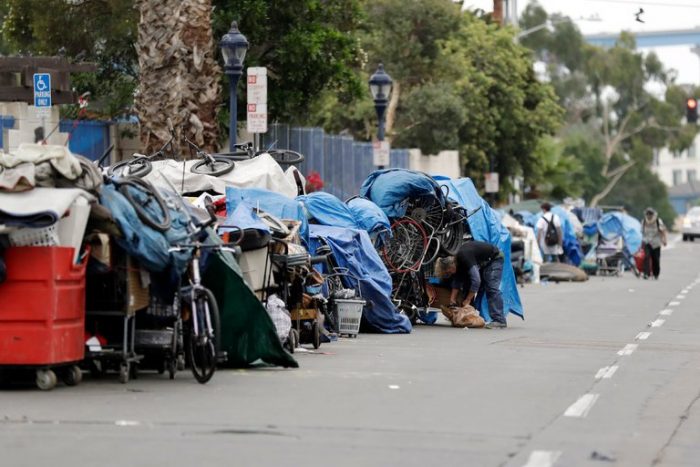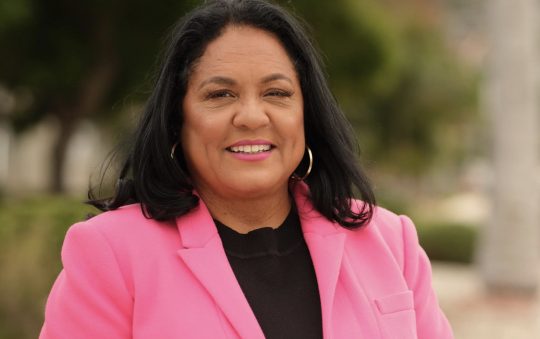The Los Angeles City Council approved a proposal recently that seeks a workable emergency strategy to provide shelter for every homeless person in the city, which at last count numbered more than 34,000 people.
The motion was introduced last month by Councilmen Mike Bonin and Marqueece Harris-Dawson. It says there is little evidence that anything is being done to create more or better shelters for the homeless in the city and that a true sense of emergency is needed to deal with the problem.
“What I wanted to do with this motion with Mr. Harris-Dawson is try to reframe how we look at this issue, with urgency and fierce impatience,” Bonin said earlier this month. “And I’ve said this many times before, but if there were a natural disaster and tens of thousands of people were forced onto the streets of our neighborhoods, we would not be responding the way that we are responding.”
The motion says the city’s 2016 Comprehensive Homelessness Strategy resolution — a $1.85 billion outline for homeless initiatives over a 10-year period — called for an expansion and “dramatic transformation” of the region’s emergency homeless shelters. But that “has not happened,” according to the councilmen.
“In fact, there is scant evidence of any progress, no apparent plan or strategy to make progress, and no evident sense of urgency or attention to any efforts to make progress,” according to their motion. “Even though officials have repeatedly declared a `state of shelter emergency,’ there is no institutional or organizational sense of emergency to move thousands of people off the streets immediately, or even in the next several weeks or months.”
The motion, which was approved with an 11-0 vote without discussion, seeks a number of actions from the Los Angeles Homeless Services Authority, which coordinates homeless services for Los Angeles County, and from some city departments. With city assistance, the authority is asked to provide several comprehensive reports within 14 days, including the framework for an Emergency Response Homeless Plan, outlining what steps and what funds would be required to provide an alternative to homeless encampments for 100 percent of the homeless population by the end of the year.
Peter Lynn, executive director of LAHSA, told the Homelessness and Poverty Committee that “we’re going to have to lift up the entire infrastructure and shelter is an important piece of it.”
Lynn also noted that since county voters approved Measure H about a year ago, which was a sales tax increase that aims to raise $355 million annually for homeless services, LAHSA has seen an increase from 10 percent to 50 percent in the number of people who enter temporary shelters in the county and are transitioned into permanent supportive housing.
“That’s a program change with funding behind it, so the results can be dramatically improved with the right funding and the right programmatic changes, and the systemic infrastructure behind it to move people through,” Lynn said. “I’m happy to address this and lay it before the council the kinds of numbers that you are talking about. These are not small numbers, and you know that.”
Homelessness in the city of Los Angeles jumped by 20 percent in 2017 while the county saw a spike of 23 percent compared to the previous year, according to the results of the 2017 Greater Los Angeles Homeless Count. In the city, the total number of homeless went up to 34,189 and the county number increased to 57,794.
The city’s biggest response to the problem of homelessness the last few years was the passage in 2016 of Proposition HHH, a $1.2 billion bond measure to fund permanent housing for the homeless, but the units will take years to approve and build.
“Los Angeles must provide genuine alternatives to sidewalk encampments — urgently,” the Bonin/Harris-Dawson motion states.
The motion also asks LAHSA to provide information on how many homeless people are currently being provided shelter or housing, how many it aims to house by the end of this fiscal year and the next three fiscal years, what steps have been taken to replace barracks-style shelters with 24-hour crisis housing and bridge housing, and what steps have been taken to recruit houses of worship and other nonprofits to provide shelter beds.
The motion also directs the Los Angeles homeless coordinator to provide a list of every public facility in the city legally eligible to be used to provide shelter, temporary housing or safe parking.








